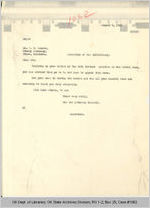Tulsa Race Massacre collection
1,327 documents and images documenting the investigation into the Tulsa Race Massacre of 1921 and Tulsa during the early 1920s.
More About This Collection
Date of Original
1919/1923
Subject
African Americans--Oklahoma--Tulsa-History
Riots--Oklahoma--Tulsa--History--20th century
Massacres--Oklahoma--Tulsa--History--20th century
Tulsa (Okla.)--Race relations
Violence--Oklahoma--Tulsa--History--20th century
African American neighborhoods--Oklahoma--Tulsa--History--20th century
Racism--Oklahoma--Tulsa--History--20th century
Riots--Oklahoma--Tulsa--History--20th century-Sources
Massacres--Oklahoma--Tulsa--History--20th century-Sources
Location
United States, Oklahoma, Tulsa County, Tulsa, 36.15398, -95.99277
Medium
records
photographs
Type
StillImage, Text
Description
Housed in the Oklahoma State Archives, this digital collection features 1, 327 documents and images from various state government agencies, such as the governor's office and the attorney general's office, regarding the investigation into the Tulsa Race Massacre of 1921. The collection includes, for example, eyewitness testimony, letters and telegrams, and police reports. State Supreme Court cases relating to the massacre, too large to include in the current digital collection, are available for viewing at the Oklahoma State Archives: Waldrep v. Exchange State Bank of Keifer, No. 9798 (1921). Robertson v. Chapel, No. 15291 (1925) Sanford v. Markham, No. 14713 (1923) Kithcart v. Feldman, No. 10822 (1923) Spencer Chapel Methodist Episcopal Church v. Brogan, No. 15201 (1924) Redfearn v. American Cent. Ins. Co., No. 15851 (1926) Available through Oklahoma Crossroads, this digital collection also includes documents about vice conditions, such as prostitution, gambling, and illegal drink, in Tulsa during the early 1920s. The Tulsa Race Massacre Story: This collection details one of the darkest episodes in Oklahoma History. The 1921 Tulsa Race Massacre constituted two days of violence that left an unconfirmed number of dead citizens and destroyed 35 square blocks of the prosperous Greenwood neighborhood, once known as "Black Wall Street." It never recovered. An examination of several telegrams between the National Guard's office and the Tulsa police chief communicated events as they unfolded providing researchers with a vivid illustration of the night of May 31st. The Tulsa Race Riot Reconciliation Commission, a state-appointed investigatory commission assembled in 2001, discovered the State Archives massacre related documents and used them with regular frequency. Due to their rarity and preservation concerns it became of vital importance to digitize the collection. Several journal articles and books have been written incorporating these records as well.
Rights Holder
Oklahoma State Archives Division, Oklahoma Department of Libraries. For further information regarding the rights to this collection, please visitwww.crossroads.odl.state.ok.us/cdm4/rights.php
Contributing Institution
Oklahoma. Department of Libraries
